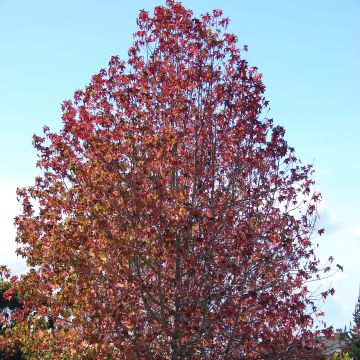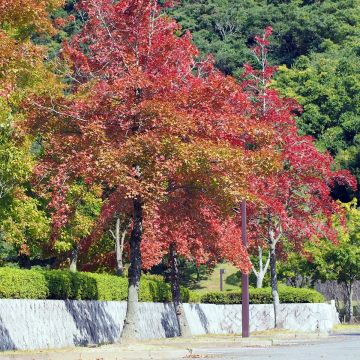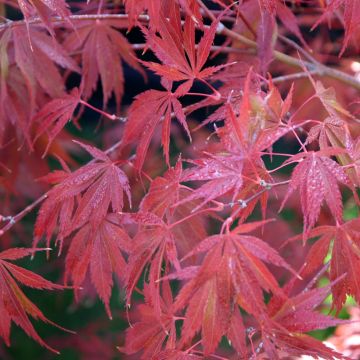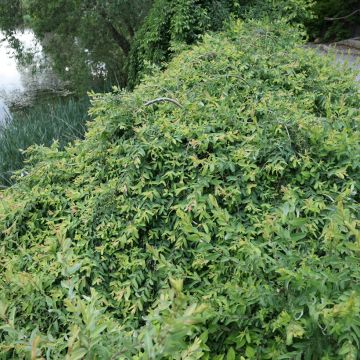

Liquidambar styraciflua Aurora


Liquidambar styraciflua Aurora


Liquidambar styraciflua Aurora
Liquidambar styraciflua Aurora
Liquidambar styraciflua Aurora
American Sweetgum, Redgum, Alligator-wood, Sapgum
This item cannot be shipped to the selected country
Oversize package delivery charge from €6.90
More information
Schedule delivery date,
and select date in basket
This plant carries a 24 months recovery warranty
More information
We guarantee the quality of our plants for a full growing cycle, and will replace at our expense any plant that fails to recover under normal climatic and planting conditions.
Oversize package: home delivery by special carrier from €6.90 per order..
Express home delivery from €8.90.
Does this plant fit my garden?
Set up your Plantfit profile →
Description
Liquidambar styraciflua Aurora is a variety of American Sweetgum with moderate growth, as opposed to the species, it reaches a height of 7 to 8 m at maturity. The colour of its leaves ranges from dark green to light green, while others are partially or largely variegated with yellow on the edges. When yellow dominates the majority of the leaf, green appears in central spots and splashes. This more compact cultivar is also denser in foliage. It forms a small, elegant tree with a pyramidal and regular habit and superb autumn foliage, ranging from orange to crimson red, or vibrant pink-red.
The American Sweetgum belongs to the Hamamelidaceae family, which includes several species with colourful autumn foliage. It is native to North America, where it grows along the banks of large rivers like the Mississippi. When the species reaches a height of 20 m, the Aurora cultivar reaches a height of 7 to 8 m and a width of 5 m. Its growth is relatively fast. With a very regular appearance, it develops a very vertical trunk and branches arranged in a staggered manner, forming a low canopy and a crown of closely spaced and dense foliage. Its deciduous foliage is beautiful in shape and changing colours. The leaves are palmate, with 5 to 9 pointed lobes and finely toothed edges, arranged alternately on the branches. They persist on the tree for a long time. In spring, the leaves can be dark green, light green, or widely variegated with yellow, with green spots and splashes. They take on beautiful autumnal shades of orange or scarlet red quite late. The spring flowers are insignificant. After pollination, pom-pom-like fruits form, somewhat resembling those of the plane tree. Each fruit is composed of several capsules that contain small winged seeds, similar to maple samaras. Once fallen, the fruits may require some cleaning. The bark of the liquidambar is dark brown, with corky crevices. This beautiful tree can live for more than 80 years.
This hardy tree appreciates deep, moist, humus-bearing soils, and can tolerate brief periods of flooding. It prefers slightly acidic to neutral soils, without too much limestone. Pruning is unnecessary, except to remove crossing or dead branches. The modest growth of Liquidambar styraciflua Aurora makes it suitable for both gardens and parks. Find a clear and sunny location for it, where its natural habit can fully express itself. In well-drained soil, it can be planted as a standalone specimen or enjoy the company of other trees that compete in beauty during autumn such as ginkgo biloba, maples, mountain ash, or witch hazel.
Report an error about the product description
Liquidambar styraciflua Aurora in pictures


Plant habit
Flowering
Foliage
Botanical data
Liquidambar
styraciflua
Aurora
Altingiaceae
American Sweetgum, Redgum, Alligator-wood, Sapgum
Cultivar or hybrid
Other Liquidambar - Sweetgum
Planting and care
Liquidambar styraciflua Aurora thrives in the sun, sheltered from strong winds, in a light and deep soil, moist but not waterlogged, preferably acidic and definitely not chalky, preferably humus-rich and loamy. When planting, mix your soil with 50% compost. Pruning is not necessary. Water regularly in the first years to help it establish and apply a base fertiliser every spring. It is resistant to diseases and pests.
Planting period
Intended location
Care
This item has not been reviewed yet - be the first to leave a review about it.
Striking foliage shrubs
Haven't found what you were looking for?
Hardiness is the lowest winter temperature a plant can endure without suffering serious damage or even dying. However, hardiness is affected by location (a sheltered area, such as a patio), protection (winter cover) and soil type (hardiness is improved by well-drained soil).

Photo Sharing Terms & Conditions
In order to encourage gardeners to interact and share their experiences, Promesse de fleurs offers various media enabling content to be uploaded onto its Site - in particular via the ‘Photo sharing’ module.
The User agrees to refrain from:
- Posting any content that is illegal, prejudicial, insulting, racist, inciteful to hatred, revisionist, contrary to public decency, that infringes on privacy or on the privacy rights of third parties, in particular the publicity rights of persons and goods, intellectual property rights, or the right to privacy.
- Submitting content on behalf of a third party;
- Impersonate the identity of a third party and/or publish any personal information about a third party;
In general, the User undertakes to refrain from any unethical behaviour.
All Content (in particular text, comments, files, images, photos, videos, creative works, etc.), which may be subject to property or intellectual property rights, image or other private rights, shall remain the property of the User, subject to the limited rights granted by the terms of the licence granted by Promesse de fleurs as stated below. Users are at liberty to publish or not to publish such Content on the Site, notably via the ‘Photo Sharing’ facility, and accept that this Content shall be made public and freely accessible, notably on the Internet.
Users further acknowledge, undertake to have ,and guarantee that they hold all necessary rights and permissions to publish such material on the Site, in particular with regard to the legislation in force pertaining to any privacy, property, intellectual property, image, or contractual rights, or rights of any other nature. By publishing such Content on the Site, Users acknowledge accepting full liability as publishers of the Content within the meaning of the law, and grant Promesse de fleurs, free of charge, an inclusive, worldwide licence for the said Content for the entire duration of its publication, including all reproduction, representation, up/downloading, displaying, performing, transmission, and storage rights.
Users also grant permission for their name to be linked to the Content and accept that this link may not always be made available.
By engaging in posting material, Users consent to their Content becoming automatically accessible on the Internet, in particular on other sites and/or blogs and/or web pages of the Promesse de fleurs site, including in particular social pages and the Promesse de fleurs catalogue.
Users may secure the removal of entrusted content free of charge by issuing a simple request via our contact form.
The flowering period indicated on our website applies to countries and regions located in USDA zone 8 (France, the United Kingdom, Ireland, the Netherlands, etc.)
It will vary according to where you live:
- In zones 9 to 10 (Italy, Spain, Greece, etc.), flowering will occur about 2 to 4 weeks earlier.
- In zones 6 to 7 (Germany, Poland, Slovenia, and lower mountainous regions), flowering will be delayed by 2 to 3 weeks.
- In zone 5 (Central Europe, Scandinavia), blooming will be delayed by 3 to 5 weeks.
In temperate climates, pruning of spring-flowering shrubs (forsythia, spireas, etc.) should be done just after flowering.
Pruning of summer-flowering shrubs (Indian Lilac, Perovskia, etc.) can be done in winter or spring.
In cold regions as well as with frost-sensitive plants, avoid pruning too early when severe frosts may still occur.
The planting period indicated on our website applies to countries and regions located in USDA zone 8 (France, United Kingdom, Ireland, Netherlands).
It will vary according to where you live:
- In Mediterranean zones (Marseille, Madrid, Milan, etc.), autumn and winter are the best planting periods.
- In continental zones (Strasbourg, Munich, Vienna, etc.), delay planting by 2 to 3 weeks in spring and bring it forward by 2 to 4 weeks in autumn.
- In mountainous regions (the Alps, Pyrenees, Carpathians, etc.), it is best to plant in late spring (May-June) or late summer (August-September).
The harvesting period indicated on our website applies to countries and regions in USDA zone 8 (France, England, Ireland, the Netherlands).
In colder areas (Scandinavia, Poland, Austria...) fruit and vegetable harvests are likely to be delayed by 3-4 weeks.
In warmer areas (Italy, Spain, Greece, etc.), harvesting will probably take place earlier, depending on weather conditions.
The sowing periods indicated on our website apply to countries and regions within USDA Zone 8 (France, UK, Ireland, Netherlands).
In colder areas (Scandinavia, Poland, Austria...), delay any outdoor sowing by 3-4 weeks, or sow under glass.
In warmer climes (Italy, Spain, Greece, etc.), bring outdoor sowing forward by a few weeks.























































